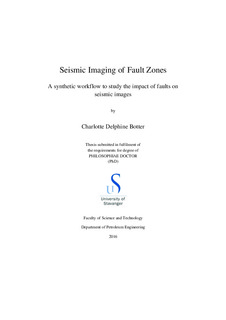| dc.contributor.advisor | Cardozo, Nestor Fernando | |
| dc.contributor.author | Botter, Charlotte Delphine | |
| dc.date.accessioned | 2016-06-07T06:26:43Z | |
| dc.date.available | 2016-06-07T06:26:43Z | |
| dc.date.issued | 2016-06-02 | |
| dc.identifier.citation | Seismic Imaging of Fault Zones : A synthetic workflow to study the impact of faults on seismic images by Charlotte Delphine Botter, Stavanger : University of Stavanger, 2016 (PhD thesis UiS, no. 293) | nb_NO |
| dc.identifier.isbn | 978-82-7644-648-7 | |
| dc.identifier.issn | 1890-1387 | |
| dc.identifier.uri | http://hdl.handle.net/11250/2391582 | |
| dc.description | PhD thesis in Petroleum engineering | nb_NO |
| dc.description.abstract | Although typically interpreted as 2D surfaces, faults are 3D narrow zones of highly and heterogeneously strained rocks with petrophysical properties differing from the host rock. Fault zones have been extensively studied in outcrop, but in the subsurface they have barely been explored, mainly because they have low signal-to-noise ratio on seismic, are often at the limit of seismic resolution, and are rarely drilled and cored. To evaluate the potential of seismic data for imaging fault structure and properties, we introduce a forward seismic modelling workflow consisting of four steps: fault modelling, elastic properties definition, seismic modelling, and seismic interpretation. This workflow is applied to normal faulting in siliciclastic sequences.
In the first paper, we implement the workflow using a methodology consisting of a discrete element model (DEM) of faulting, empirical relations to modify the initial acoustic properties of the model based on volumetric strain, a ray-based algorithm simulating pre-stack depth migration (PSDM) results, and interpretation and correlation of the seismic and input properties. This methodology is applied in 2D to a large-scale (100 m displacement) normal fault in a sandstone-shale sequence at reservoir depths, for two DEM particle-size resolutions, one finer than the other. Both simulations produce realistic fault geometries and strain fields, with the finer particle-size model displaying narrower fault zones and fault linkage at later stages. Seismic imaging and resolution of these two models are highly influenced by illumination direction and wave frequency. At high wave frequencies, there is a direct correlation between seismic amplitude variations and the input acoustic properties after faulting.
The second paper uses the same methodology, but in 3D for a normal fault with large displacement in a sandstone-shale sequence for two cases, one with constant fault displacement and another with linearly variable displacement along strike. High frequencies on seismic images show the impact of the fault on the offset and distortion of the reflectors. In the variable fault-slip model, the fault has less impact as the displacement decreases, and the fault tipline can be interpreted. We extract fault geobodies using an adapted attribute-based workflow. The geobody for the constant fault displacement model corresponds to an inner high-deformation area within the fault zone, while in the variable fault-slip model the geobody captures better the entire fault zone.
Finally in the third paper, we illustrate the workflow using an outcrop-based simulated fluid flow model from the Delicate Arch Ramp (Utah), to study the impact of relay ramps and their fluid composition on seismic data. Changes in porosity in the fault damage zones are visible in the oil-saturated model at the beginning of the simulation, whereas the water-oil contacts have stronger impact on seismic at later stages. We extract volumes corresponding to the two faults and the relay ramp from the three seismic cubes with an adapted tuning of the attribute-based workflow. By varying input and imaging parameters, we also show reservoir and acquisition conditions that affect the resolution of the relay ramp seismic image.
Through this interdisciplinary research, we show the potential of seismic data for specific fault characterisation, as well as the tuning of acquisition and processing parameters, and interpretation routines required to map faults and their associated deformation. This research has major implications for hydrocarbon exploration and production, storage of subsurface waste, and hydrogeological and geothermal systems. | nb_NO |
| dc.language.iso | eng | nb_NO |
| dc.publisher | University of Stavanger, Norway | nb_NO |
| dc.relation.ispartofseries | PhD thesis UiS;293 | |
| dc.relation.haspart | Botter, Charlotte; Cardozo, Nestor; Hardy, Stuart; Lecomte, Isabelle & Escalona, Alejandro (2014): From mechanical modeling to seismic imaging of faults: a synthetic workflow to study the impact of faults on seismic. Marine and Petroleum Geology, 57, 187-207 doi: http://dx.doi.org/10.1016/j.marpetgeo.2014.05.013 | nb_NO |
| dc.relation.haspart | Botter, Charlotte; Cardozo, Nestor; Hardy, Stuart; Lecomte, Isabelle; Paton, Gaynor & Escalona, Alejandro: Seismic characterisation of fault damage in 3D using mechanical and seismic modelling. Submitted to Marine and Petroleum Geology, January 2016. | nb_NO |
| dc.relation.haspart | Botter, Charlotte; Cardozo, Nestor; Lecomte, Isabelle; Rotevatn, Atle & Paton, Gaynor: The impact of faulting and fluid flow on seismic images of a relay ramp. Submitted to Petroleum Geoscience, thematic set on fault and top seals, February 2016. | nb_NO |
| dc.rights | Copyright the author, all right reserved | |
| dc.rights | Navngivelse 3.0 Norge | * |
| dc.rights.uri | http://creativecommons.org/licenses/by/3.0/no/ | * |
| dc.subject | petroleumsteknologi | nb_NO |
| dc.subject | seismic imaging | nb_NO |
| dc.subject | seismikk | nb_NO |
| dc.title | Seismic Imaging of Fault Zones : A synthetic workflow to study the impact of faults on seismic images | nb_NO |
| dc.type | Doctoral thesis | nb_NO |
| dc.subject.nsi | VDP::Technology: 500::Rock and petroleum disciplines: 510::Petroleum engineering: 512 | nb_NO |

